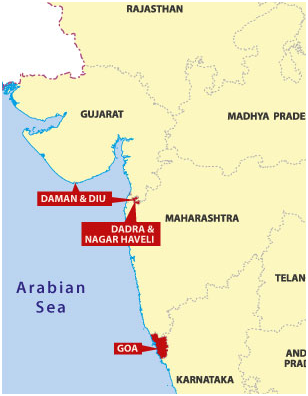

Recently, a bill for the merger of Union Territories of Dadra and Nagar Haveli and Daman and Diu was introduced in the Parliament by Home Minister.
Context
Recently, a bill for the merger of Union Territories of Dadra and Nagar Haveli and Daman and Diu was introduced in the Parliament by Home Minister.
About
- The Bill provides for the merger of the Union Territories (UTs) of Dadra and Nagar Haveli, and Daman and Diu into a single UT.
- Key features of the Bill include:
- Amendment of the Constitution:The First Schedule to the Constitution specifies the territories that come under various states and UTs. The Bill amends the First Schedule to merge the territories of the two UTs: (a) Dadra and Nagar Haveli, and (b) Daman and Diu. The merged territory will form the UT of Dadra and Nagar Haveli and Daman and Diu. This will come into effect from the day notified by the central government.
Daman and Diu and Dadra and Nagar Haveli
These two UTs are located in the western region of India.
- Daman and Diu are two widely separated districts situated on the southern side of Gujarat. Daman is an enclave on Gujarat’s southern coast and Diu encompasses an island off the southern coast of Gujarat’s Kathiawar Peninsula. It is in close proximity of the UT of DNH.
- Dadra and Nagar Haveli consists of two separate parts. Dadra is surrounded by the state of Gujarat and Nagar Haveli lies on the borders of Maharashtra and Gujarat.
- Both were colonised by the Portuguese and were liberated in December 1961.
- In 1987, when Goa got statehood, Daman and Diu were made a separate Union Territory from the previous Union Territory of Goa, Daman and Diu.
- Daman and Diu are two widely separated districts situated on the southern side of Gujarat. Daman is an enclave on Gujarat’s southern coast and Diu encompasses an island off the southern coast of Gujarat’s Kathiawar Peninsula. It is in close proximity of the UT of DNH.
- Amendment of the Constitution:The First Schedule to the Constitution specifies the territories that come under various states and UTs. The Bill amends the First Schedule to merge the territories of the two UTs: (a) Dadra and Nagar Haveli, and (b) Daman and Diu. The merged territory will form the UT of Dadra and Nagar Haveli and Daman and Diu. This will come into effect from the day notified by the central government.
- Article 240(1) of the Constitution allows the President to make regulations for certain UTs, including the UTs of Dadra and Nagar Haveli, and Daman and Diu. The Bill amends the Article to replace these two UTs with the merged UT.
- Representation in Lok Sabha:The First Schedule to the Representation of the People Act, 1950 provides one seat in Lok Sabha to each of the two UTs. The Bill seeks to amend the Schedule to allocate two Lok Sabha seats to the merged UT.
- Services under the UTs: Every person employed in connection with the affairs of the existing UTs will provisionally serve the merged UT. The central government will determine whether every such person will finally be allotted for service in the merged UT.
- The merged UT will take steps to integrate employees into services under its control. The central government may give orders and instructions to the merged UT in this regard.
- The central government may establish Advisory Committees to assist in ensuring fair treatment of all persons affected by these provisions and consideration of any representations made by them. Representations against any service orders must be made within three months from the date of publication, or notice of the order, whichever is earlier.

- These provisions will not apply to members of All India Services (such as Indian Administrative Services, Indian Police Services, and Indian Forest Services), and persons on delegation from any state.
- Jurisdiction of High Court: The Bill provides that the jurisdiction of the High Court of Bombay will continue to extend to the merged UT.
Reasons for Merging Two UTs
- Both UTs have two separate constitutional and administrative bodies which lead to a lot of duplicacy, inefficiency and wasteful expenditure.
- The merger will help in achieving the government’s goal to have Minimum Government, Maximum Governance.
- Both of them have small population and limited geographical area so the merger will not be challenging and the services of officers will be used efficiently.


